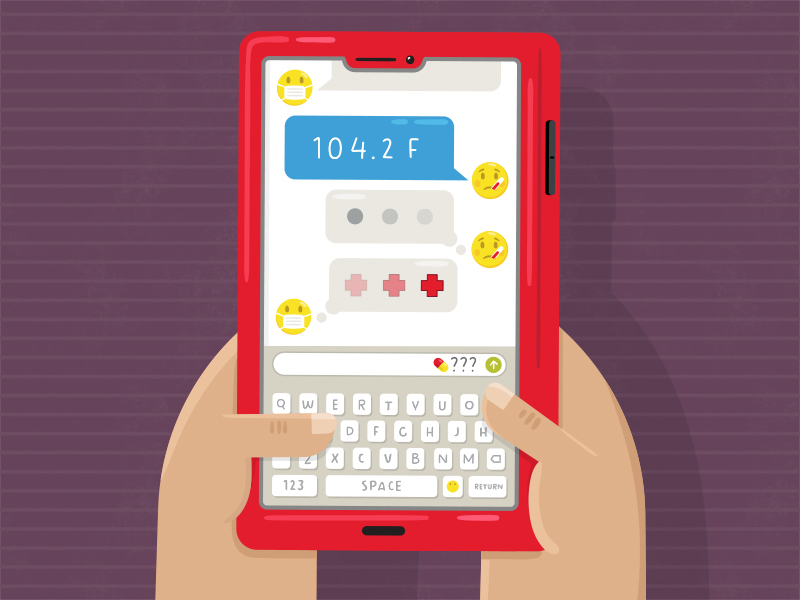Takeaways
- The COVID-19 pandemic was the first widescale deployment of chatbots to address the same health crisis and quickly disseminate accurate information.
- Chatbots handled thousands of basic, repetitive questions when doctors’ offices and public health agencies were overtaxed with phone calls.
- Studying what chatbot technology worked during the pandemic will provide useful guidance for the next public health emergency.
Scalable to answer thousands of questions simultaneously, easily accessible to the public, and enabling social distancing, chatbots were ubiquitous during the COVID-19 pandemic.
But not all chatbots are created equal, according to Elena Karahanna, UGA Distinguished Research Professor in the Department of Management Information Systems at the Terry College of Business. Karahanna, who studies the use of chatbots and social media in health care settings, published an analysis of how chatbots were used in response to COVID-19.
“A lot of out-of-the-box tools developed during the pandemic offer customization options so organizations and agencies can tailor them to their needs,” said Karahanna, who also serves as the C. Herman and Mary Virginia Terry Distinguished Chair of Business Administration. “Our study informs what should be prebuilt and what customization options would be useful for the next pandemic or public health crisis.”
The paper, co-authored with former Terry Ph.D. student Parham Amiri, catalogs the novel ways chatbots were deployed in the public health response to this pandemic and offers strategies to answer future health crises. “Chatbot use cases in the COVID-19 public health response” appeared in the February edition of the Journal of the American Medical Informatics Association.
Chatbots have helped health departments answer questions patients might be too embarrassed to ask in person, provide health care education, or schedule appointments. But there wasn’t a widescale deployment of chatbots to address the same health challenge until 2020, when health departments, hospitals and government agencies stood up chatbots to assess risk and quickly disseminate accurate information.
Karahanna and Amiri analyzed the use of public-health response chatbots presented in English language research papers in 2020 and 2021. Their sample included 61 COVID-specific chatbots in 30 countries. They weren’t looking to take a census of all chatbots used but to take a snapshot of the ways they were being used.
They found bots being used in a few common ways.
“One of the things chatbots are good at is handling a lot of parallel questions at the same time from thousands and thousands of users,” Karahanna said. “With the fast-shifting landscape of information about the virus during the pandemic, there was confusion and a huge need for information … Doctors’ offices and public health agencies were overtaxed with phone calls. Chatbots expanded their capacity by offloading some of those repetitive questions from humans to a machine so humans could handle more complicated tasks.”
Hospitals and public health organizations used bots to risk assess and triage patients to prevent exposed individuals from flooding emergency rooms. They also collected broad symptom data to pinpoint hotspots, while others allowed patients to schedule tests or vaccines. The fourth group of bots connected doctors, nurses and public health officials in rural areas with their country’s central health ministry.
One thing distinguishing bots across countries was the anonymity of the user. Some cultures place less of a premium on privacy, and bots in these countries provide more follow-up services because the interactions weren’t anonymous. This would not work everywhere, Karahanna said.
Decisions about anonymity are made on an agency-by-agency basis because using a chatbot that violates privacy expectations could result in an unused tool.
This wide-ranging experimentation with chatbot use during this pandemic helps the public health establishment prepare for the next health crisis.
“The content is pandemic specific, but we now know what will work,” Karahanna said. “We can provide guidelines as to what we need to build.”
Knowing what’s needed for a response may also minimize duplication efforts and enhance the bot’s quality.
“Chatbot technology is improving, but during the pandemic, many of these were built very quickly to address pressing needs, and they were not as user-friendly or sophisticated,” Karahanna said. “We can learn what we need and possibly develop modules that can be customized for different organizations so we’re not having to reinvent the wheel next time.”

